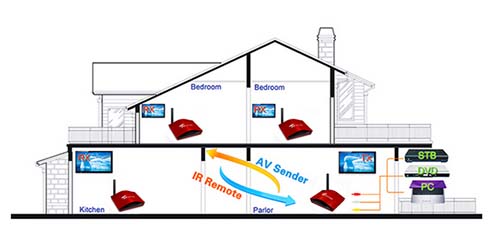Digital/Analog wireless TV sender
A wireless tv sender (also known as a audio video transmitter receiver, wireless video sender, wireless AV sender or DigiSender) is a device for transmitting domestic audio and video signals wirelessly from one location to another. It is most commonly used for sending the output of a source device, such as a satellite television decoder, to a television in another part of a property and provides an alternative to cable installations.
A wide range of wireless tv sender technologies exist, including analogue wireless (radio), digital wireless (spread-spectrum, Wi-Fi, ultra-wideband) and digital wired (power-line communication). Other, less common, technologies also exist, such as those that utilise existing Ethernet networks.
A typical wireless tv sender kit containing a transmitter, receiver, magic eye and a remote control to select the input.
A wide range of wireless tv sender technologies exist, including analogue wireless (radio), digital wireless (spread-spectrum, Wi-Fi, ultra-wideband) and digital wired (power-line communication). Other, less common, technologies also exist, such as those that utilise existing Ethernet networks.
A typical wireless tv sender kit containing a transmitter, receiver, magic eye and a remote control to select the input.
Video senders have been a frequent cause of RF interference, particularly with car key fobs
Overview
Typical wireless av sender applications include the transmission of television audio and video signals from a lounge to a bedroom or from a CCTV camera to a display, as well as interconnecting appliances with audio, video and IP (Internet Protocol) requirements.
Most wireless tv sender systems will consist of three separate components, a transmitter, a receiver and a remote control relay (also known as a magic eye or IR blaster). The transmitter is responsible for transmitting or broadcasting a connected audio-video device, while the receiver outputs that transmitted audio-video signal to a connected television. The remote control relay permits infrared remote controls to operate the equipment whose output is being transmitted.
Most wireless tv sender systems will consist of three separate components, a transmitter, a receiver and a remote control relay (also known as a magic eye or IR blaster). The transmitter is responsible for transmitting or broadcasting a connected audio-video device, while the receiver outputs that transmitted audio-video signal to a connected television. The remote control relay permits infrared remote controls to operate the equipment whose output is being transmitted.
Analogue wireless
Analogue video senders have the advantage of low manufacturing costs as the audio and video signals are simply modulated onto a carrier at 2.4 GHz or 5.8 GHz. They do, however, have the adverse effect of causing reduced bandwidth to local Wi-Fi networks and, in some cases, Wi-Fi networks can cause picture interference on the video sender signal. More information can be found in the article on electromagnetic interference at 2.4 GHz. To avoid this, some video senders now use a spread-spectrum technology and can co-exist with wireless networks and share available bandwidth.
Usually there are four FM transmit channels, A, B, C & D, with stereo audio on 6.0 MHz and 6.5 MHz FM subcarriers added to the composite video baseband. These different channels can often be used to overcome the adverse effects of nearby WiFi networks.
The reverse remote control channel is usually fixed at 433.92 MHz, using whatever modulation is on the 34 kHz to 45 kHz IR remote "carrier".
Analogue wireless tv senders can achieve typical operating distances of up to 60 metres (clear line of sight) with DVD quality (720x576) video resolution and stereo audio.
Usually there are four FM transmit channels, A, B, C & D, with stereo audio on 6.0 MHz and 6.5 MHz FM subcarriers added to the composite video baseband. These different channels can often be used to overcome the adverse effects of nearby WiFi networks.
The reverse remote control channel is usually fixed at 433.92 MHz, using whatever modulation is on the 34 kHz to 45 kHz IR remote "carrier".
Analogue wireless tv senders can achieve typical operating distances of up to 60 metres (clear line of sight) with DVD quality (720x576) video resolution and stereo audio.
Digital wireless
Digital wireless av senders are quickly becoming the most popular solution and combine the use of a system on chip (used for audio and video encoding/decoding) with a means of transmitting the signal, such as spread-spectrum, Wi-Fi and ultra-wideband.
Artical from: Wireless digital/analog TV sender
Good news: PAKITE wireless hdmi transmitter and receiver with hdmi jack is coming soon, and the hdmi sender is used for the TV device with hdmi port. Waiting for your inquiry about the hdmi wireless transmitter.
recommend reading:
5.8GHz Wireless Audio/Video Sender with IR Remote Control ExtenderWhich AV Sender is right for you?
PAKITE Wireless IR Extender PAT-433

No comments:
Post a Comment